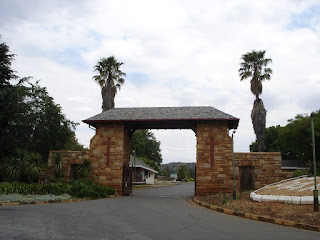 |
Jessica who is South African and who also lived within apartheid as a child and young person |
 |
Nelson Mandela who towers in great stature throughout the struggle against apartheid |
 |
The entrance to the museum suggesting a place of oppression and imprisonment but with the pillars of the constitution of the new South Africa standing proudly outside its walls . |
Visitors at the Apartheid Museum in Johannesburg proceed through the courtyard past seven pillars, each celebrating one of the cornerstones of the South African Constitution Democracy, Equality, Diversity, Respect, Freedom, Responsibility and Reconciliation.
 |
Jessica and Gay beginning a journey with mirrors showing that we too are on the journey through to a new era. |
 |
the gates to the cemetery had been made of wood in the fifties but had been knocked into and damaged by a tractor and so replaced. |
 |
The flowers sellers were alongside the walls in those days. It was well known that they would sell the flowers during the day and sometimes climb the walls at night to get the flowers back and resell them! At 5 every evening a night security patrol would report to my father and one of their tasks was to watch for the flowers sellers! |
 |
And there was the house - No 2 - one of only two houses within the cemetery . the are opposite the cemetery is now very developed but back then it was just bush |
 | ||
Growing up in a cemetery you had to make your own fun as we had no living neighbours. I had a swing in this corner where I would swing for hours with my imaginary friends. their names were all listed - names that I had read on the tombstones. We had a labrador - black - named Sally who was penned up in a run that ran alongside the garage.
|
 |
The cemetery office where my Dad worked when he wasn't in the nurseries |
 |
The current tariff and.... |
 |
.........the current admin staff. She was delightful and loved to hear my story. Her name was Elisa. |
 | ||||
Just inside the main gate is a new era for South African heroes and there we found the grave of Nkosi Johnson Nkosi Xolani Johnson was born on 4 February 1989 with HIV and was the longest surviving child born with the virus in the country. His mother has since died of Aids, and he was adopted when he was two by a foster mother, Gail Johnson. In the absence of money for drugs, Nkosi had survived on a healthy diet, vitamin supplements and minimising the stress of being HIV positive. Ms Johnson attempted to give him a purpose by turning him into a spokesman for Aids awareness at a time when the country's infected population was silenced by the suffocating stigma of fear and prejudice. But for Nkosi, who had seen his real mother die of Aids, the frightening inevitability of his own impending death was never far away. Speaking before his death Ms Johnson said: "We chatted about death... He had strong feelings about letting me down," she said. "I told him I would miss him and no one could take his place." Nkosi will be particularly remembered for a speech he made at the World Aids Conference in Durban in July 2000. He told delegates:
He also scolded South African President Thabo Mbeki on his government's failure to provide drugs, which caused the miffed president to leave during the speech. He later told the BBC:
In December 2000 Nkosi had a relapse and remained critical until his death. On 1 June 2001 a Johnson family spokesman said that Nkosi died at 0540 local time (0340 GMT) after a desperate final battle against the disease. Ms Johnson said:
Former South African president Nelson Mandela said he was an example for the whole world to follow. Mr Mandela told reporters:
|
 |
The grave of a famous freedom fighter |
 |
I'm sure those are the same palm trees. My mother learnt to drive in this cemetery with its many roads with stop signs and roundabouts! She never did drive on the roads of Joh'burg but managed to drive around Kitwe very competently for many months before she was persuaded to go for a test! |
 |
| roads |
 |
The cemetery was traditionally divided into sections. This was the Portuguese section |
 |
When I was a little girl growing up in West Park I would spend ours wandering around the different sections. My favourite were the children's sections. I was fascinated by their tiny stories on the stones and the angels that adorned them. I knew where the dump was for the flowers that had died on the graves and once collected a big bag of ribbons for which I got into a lot of trouble. My father did not think it was seemly! |
 |
Jacaranda trees make a mauve carpet at this time of the year |
Just another tiny glimpse of an African childhood.......I really must write that book!








No comments:
Post a Comment